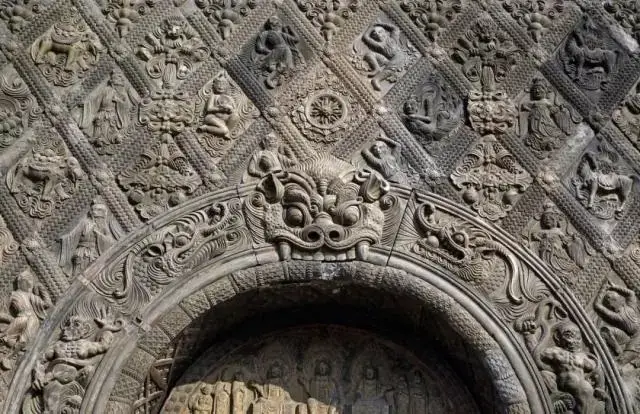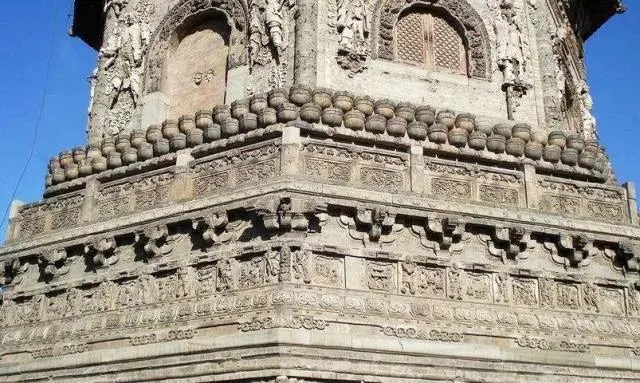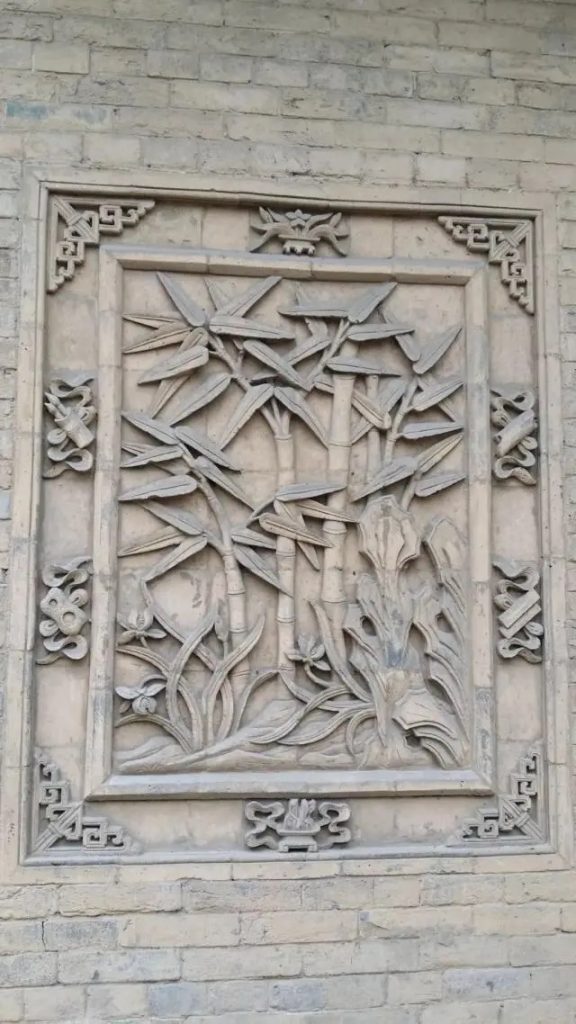Brick carving, an ancient artistic form originating in China, particularly holds profound historical roots in regions such as Shanxi and Shaanxi. Brick carving refers to the intricate carving of various patterns and images on blue bricks. Its exquisite craftsmanship and diverse forms have been widely applied in decorating and beautifying ancient architecture. The history of brick carving can be traced back to the Qin and Han dynasties, and after centuries of development, it gradually formed its unique artistic style and expression methods.
The primary raw material for brick carving is blue bricks, which are specially fired to provide a solid foundation for carving with their hard texture and deep color. During the carving process, artisans utilize various tools such as carving knives, hammers, and drills to create detailed depictions and carvings on the blue bricks. Employing techniques like line carving, bas-relief, and openwork, they vividly present patterns and images.
Brick carving covers a wide range of content with diverse themes, including landscapes, flowers and birds, figures, and mythological legends. These patterns and images carry profound cultural connotations and symbolic meanings. For example, landscape-themed brick carvings often portray the beauty of nature, symbolizing the harmonious coexistence of humans and nature. Flower and bird motifs convey auspicious, joyful, and positive wishes, while figure-themed carvings transmit moral and ethical values through depictions of historical figures or characters from myths.
The skill requirements for brick carving are exceptionally high, demanding artisans to possess both exquisite carving techniques and artistic cultivation. They need a solid foundation in painting, coupled with in-depth knowledge of historical culture. Throughout the carving process, artisans must unleash their creativity and imagination, ingeniously combining different elements to create works that are both aesthetically pleasing and culturally meaningful.
In ancient architecture, brick carving held a significant position, not only enhancing the appearance of buildings but also adding cultural connotations. Exquisite brick carvings can be observed in temples, palaces, gardens, and other structures. These works not only showcase the artisans’ exceptional skills but also reflect the aesthetic concepts and cultural traditions of that era.
With the passage of time, brick carving gradually lost its dominant position in architecture. However, as a unique art form, brick carving continues to be appreciated and cherished. Many artists and craftsmen are dedicated to preserving and developing this craft, injecting new vitality through innovation and improvement.
Modern brick carving, while preserving traditional techniques, places more emphasis on artistic and creative elements. Artists blend tradition with modernity, using contemporary technologies and materials to create works that are both timely and personalized. Simultaneously, through training and heritage activities, they cultivate successive generations of brick carving artists, infusing new vigor into the preservation and development of this craft.
As a cultural heritage and artistic form, brick carving possesses high historical and cultural value. It is not only a means of decorating ancient architecture but also an integral part of the cultural heritage of the Chinese nation. Protecting and inheriting the art of brick carving holds significant importance for promoting Chinese culture, advancing cultural diversity, and fostering artistic innovation.
History of Brick Carving
Brick carving, a unique traditional decorative art in China, has a long history and profound cultural heritage. According to historical records, brick carving originated during the Eastern Zhou period and developed continuously through the Qin and Han dynasties, eventually forming mature craftsmanship. In the long river of history, brick carving, with its exquisite carving techniques and rich cultural connotations, became an essential component of Chinese national culture.

The early stage of brick carving was mainly used for the decoration of architectural components such as tomb chambers and temples. Over time, brick carving gradually evolved into an independent art form, widely applied in architecture, gardens, and homes. In different historical periods, the techniques and styles of brick carving also underwent corresponding changes, showcasing different characteristics and charms.
The Qin and Han periods marked the sprouting period of brick carving art. During this time, shallow relief and incised lines were the main techniques, with patterns depicting auspicious elements such as cloud patterns, dragon patterns, and phoenix patterns. Representative works from this period include the fragments of brick carvings unearthed from the mausoleum of the First Emperor of the Qin Dynasty. These works feature smooth lines and vivid imagery, demonstrating the exquisite carving techniques of the Qin Dynasty.
The Tang and Song periods represented the maturity of brick carving art. With economic development and cultural prosperity, the Tang and Song periods witnessed significant achievements in brick carving art. During this time, brick carving techniques became more diverse, incorporating techniques such as high relief and openwork in addition to shallow relief and incised lines. Simultaneously, the themes of Tang and Song brick carvings expanded to include a wide range of subjects, such as traditional auspicious patterns, figures, animals, landscapes, and more. The works from this period were characterized by lifelike images and superb artistic achievements, showcasing the high level of brick carving art during the Tang and Song dynasties.
The Ming and Qing periods represented the heyday of brick carving art. During this period, brick carving works focused more on details and decoration, with more sophisticated and diverse carving techniques. Additionally, Ming and Qing brick carvings incorporated regional features and cultural elements, presenting different regional styles. In the field of architecture, brick carving was widely applied in temples, gardens, residences, becoming an essential means of architectural decoration. In terms of carving techniques, Ming and Qing brick carving emphasized the expression of hierarchy and three-dimensionality, pursuing the perfection and delicacy of details. In terms of themes, in addition to traditional auspicious patterns, there was a surge in works depicting historical stories, mythological legends, and other subjects. These works carried profound meanings and rich cultural connotations, showcasing the unique charm of Ming and Qing brick carving art.
As time progressed, brick carving gradually lost its dominant position in architecture. However, as a unique art form, brick carving continues to be appreciated and cherished by people. In modern society, many artists and craftsmen are committed to inheriting and developing this skill. Through innovation and improvement, brick carving has injected new vitality into modern society.
Modern brick carving, while preserving traditional techniques, pays more attention to artistic and creative elements. Artists integrate tradition with modernity, using contemporary technologies and materials to create works that are more in line with the times and more personalized. At the same time, through training and heritage activities, they cultivate a new generation of brick carving artists, injecting new vitality into the inheritance and development of this skill.
In conclusion, brick carving, as a unique traditional Chinese decorative art form, has a long history, exquisite craftsmanship, and rich cultural connotations. Through in-depth understanding and analysis of the techniques and styles of brick carving in different historical periods, we can better comprehend the developmental process and characteristics of this art form. Meanwhile, we should prioritize the protection and inheritance of brick carving skills, allowing this unique art form to continue and thrive in modern society.
Brick Carving Patterns
The patterns in brick carving are a crucial component of brick carving art. They serve not only as a means of decoration and beautification but also as significant carriers of cultural heritage and expression. The variety and breadth of brick carving patterns, with their profound symbolism, showcase the rich cultural connotations and artistic charm of the Chinese nation.

Among the patterns, the most common are auspicious patterns. These auspicious patterns, through symbolism, homophony, and meaning, express people’s pursuit and wishes for happiness, beauty, and auspiciousness. For instance, the lotus symbolizes purity and elegance, fish represent abundance year after year, and plum blossoms signify tenacity and strength. Widely used in the decoration of architecture and homes, these auspicious patterns embody people’s hopes and visions for the future.
In addition to auspicious patterns, brick carving patterns also encompass themes such as landscapes, flowers and birds, and figures. Through meticulous depiction and vivid representation, these themes showcase the beauty of nature and the cultural charm of humanity. The grandeur of landscapes, the splendor and vitality of flowers and birds, and the lively portrayal of figures all contribute to the rich visual effects and cultural connotations of brick carving works.
Another noteworthy category within brick carving patterns is historical stories and mythological legends. These stories and legends are vividly presented through the artistic form of brick carving. For example, characters from “Romance of the Three Kingdoms” and classic scenes from “Dream of the Red Chamber” are ingeniously incorporated into brick carving works. These works not only possess high artistic value but also stimulate people’s interest and contemplation of traditional culture.
Furthermore, brick carving patterns in different regions exhibit distinct regional characteristics. Southern brick carving patterns are delicate and exquisite, often featuring flowers and landscapes. In contrast, northern brick carving patterns are bold and unrestrained, focusing more on figures and animals. The presentation of these regional characteristics not only reflects different regional cultural traditions and aesthetic tendencies but also enriches the diversity and uniqueness of brick carving art.
Within brick carving patterns, there are also special patterns with unique meanings and functions. Some patterns are used for warding off evil and praying for blessings, such as the Bagua diagram and Zhong Kui capturing ghosts. Others are employed to seek good fortune and auspiciousness, such as the Double Happiness symbol and the symbols of prosperity, longevity, and happiness. These patterns, with special significance, play crucial roles in folk beliefs and traditional culture, adding deeper connotations and meanings to brick carving works.
With the development of time, modern brick carving patterns continue to innovate and evolve. Modern brick carving artists, while inheriting tradition, integrate modern aesthetics and creative elements, producing many novel and unique brick carving works. These works not only preserve the artistic essence and cultural connotations of traditional brick carving but also inject the fashion and individualized demands of modern society.
Characteristics of Shanxi Brick Carving Patterns
The decorative themes of Shanxi residential brick carving can be generally summarized into three categories: praying for blessings and good fortune, moral education, and warding off evil and disaster. The commonly used patterns include:
Various stories of figures, including mythological characters like “Hehe Erxian” and “Eight Immortals Crossing the Sea,” characters from traditional operas like “Oath of the Peach Garden” and “Picking up the Jade Bracelet,” children’s games such as “Five Children Competing for Victory” and “Five Children Bringing Wealth,” and historical figures like “Yanshan Teaching Children” and “Tao Yuanming’s Love for Chrysanthemums.”

Folk auspicious animal patterns, such as “Two Dragons Playing with a Pearl,” “Dragon and Phoenix Bringing Auspiciousness,” “Carp Jumping over the Dragon Gate,” “Lion Rolling a Embroidered Ball,” “Pine and Crane Prolonging Life,” “Five Blessings (Bats) Holding Longevity,” “Kylin Delivering Offspring,” “Three Yang (Sheep) Opening Peace,” “Immediately Promoted (Monkey) to a High Position (Elephant),” and “Seal (Bee) Marquis (Monkey) General (Elephant)”—reflecting people’s desires for long and prosperous lives and prosperous families.
Folk auspicious plant patterns, including seasonal flowers such as spring peonies (flower of wealth and honor), summer lotus flowers (symbolizing purity and beauty), autumn chrysanthemums, and winter plum blossoms. Other plant patterns symbolize many children and grandchildren, like “Grape Hundred Sons Pattern” and “Continuous (Lotus) Births Noble Sons Pattern.” There are also the “Four Fruits”—pomegranate (stay), Buddha’s hand (blessing and longevity), peach, and fragrant round (round), as well as symbols of longevity like lingzhi mushrooms, pine trees, and cypress trees. These patterns fully express the homeowner’s pursuit of moral cultivation and a beautiful life full of auspiciousness.
Various calligraphy carvings, including characters like “Fu” (happiness), “Lu” (wealth), “Shou” (longevity), “Xi” (joy), and inscriptions on brick door lintels like “Quiet Observation” and “Insightful.”
Additionally, there are composite patterns that ingeniously combine many coherent and vivid scenes, such as “Four Excellent Patterns” and “Twenty-Four Filial Exemplars Patterns.” There are also carvings depicting literary stories, opera stories, folk customs, mythological stories, and folk legends. Overall, these patterns represent diverse aspects of life and culture.
Types of Brick Carving
Brick carving is an artistic form that utilizes bricks as a medium to express various patterns and images through carving. There are diverse types of brick carving, and based on different classification criteria, brick carving can be categorized into various types.
According to carving techniques, brick carving can be classified into several types, including flat carving, relief carving, hollow carving, and through carving. Flat carving involves directly carving patterns on the surface of bricks, creating shallow textures. Relief carving protrudes patterns from the brick surface, providing a three-dimensional effect. Hollow carving involves carving inside the brick, creating a hollow effect in the pattern. Through carving removes certain parts of the pattern, resulting in a semi-transparent effect.
Based on purpose and decorative locations, brick carving can be categorized into wall brick carving, floor brick carving, roof brick carving, and other types. Wall brick carving is primarily used for decorating walls, partitions, and similar areas; floor brick carving is used for floor decoration, while roof brick carving is applied to decorate roofs and eaves.
Additionally, based on region and artistic style, brick carving can be classified into different types. For example, Huizhou-style brick carving, Jin-style brick carving, Suzhou-style brick carving, each with its distinctive characteristics, showcasing the cultural traits and artistic styles of different regions and schools.
Besides the aforementioned classifications, there are also special types of brick carving, such as screen wall brick carving and floral window brick carving. Screen walls are erected in courtyards as partition walls, mainly serving the purpose of obstructing lines of sight. The brick carvings on screen walls often utilize deep relief and through-carving techniques, with predominant auspicious patterns like dragons, phoenixes, and qilins. Floral window brick carving is commonly used for decorating windows in gardens, featuring a carving style that is light, transparent, and poetic.
Materials Used in Brick Carving
There are various material options for brick carving, including clay bricks, terracotta bricks, porcelain clay bricks, and more. Among these, clay bricks are the most common material for brick carving. They have the advantages of fine texture, high density, and good durability, making them suitable for carving various traditional patterns and intricate floral designs. However, clay bricks typically have a single color, commonly gray or dark gray, making them less versatile for matching with other building materials.
Terracotta bricks are also commonly used for brick carving, featuring a rough surface that provides a distinctive texture and pattern. Porcelain clay bricks have higher hardness and density, allowing for more delicate and exquisite carving effects.
In addition, some regions use materials like red clay, white mud, etc., for brick carving. Regardless of the material chosen, high-quality brick carving materials should possess characteristics such as density, freeze-thaw resistance, impact resistance, load-bearing strength, wear resistance, and corrosion resistance to ensure the quality and longevity of brick carving works.
Reference Materials
Brick Carving (Shanxi Folk House Brick Carving). China Intangible Cultural Heritage Website [Accessed on September 5, 2020].
Notice of the State Council on the Announcement of the Second Batch of National Intangible Cultural Heritage List and the First Batch of National Intangible Cultural Heritage Expansion Project List. The State Council of the People’s Republic of China [Accessed on March 30, 2021].
Li Nan, Ed. (2015). “Ancient Chinese Bricks and Tiles.” Beijing: China Commerce and Trade Press, pp. 95-96.
Jia Xiaojun. (2020). “The Influence of Shanxi Folk House Brick Carving by Jin Merchants Culture.” Western Leather, (Issue 8), p. 110.
Linglong, Ed. (2014). “Shining Brilliance: Collection and Appreciation of Stone Carving and Brick Carving.” Beijing: New World Press, p. 235.
Zhang Chao, Ed. (2012). “Introduction to Chinese Carving Culture.” Beijing: Beijing University of Technology Press, pp. 34-35.